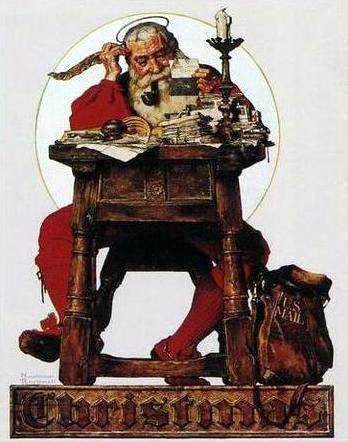|
 Santa
Claus has not always appeared the way we think of him today.
The first well-known gift-giver was a true person--St. Nicholas.
He lived in Myra (today we know it as Turkey) in about 300A.D.
Born an only child of a wealthy family, he was orphaned at an early age
when both parents died of the plague. He
grew up in a monastery, and at the age of 17 became one of the youngest priests
ever.
Santa
Claus has not always appeared the way we think of him today.
The first well-known gift-giver was a true person--St. Nicholas.
He lived in Myra (today we know it as Turkey) in about 300A.D.
Born an only child of a wealthy family, he was orphaned at an early age
when both parents died of the plague. He
grew up in a monastery, and at the age of 17 became one of the youngest priests
ever.
Some years later Nicholas became a bishop--hence the bishop's hat or
miter, long flowing gown, white beard and red cape.
After his death he was elevated to sainthood.
Eventually the Catholic Church started celebrating Christmas and St.
Nicholas was incorporated into the season.
Many stories are told of his generosity as he gave his wealth away in the
form of gifts to those in need, especially children.
Legends tell of him either dropping bags of gold down chimneys or
throwing the bags through the windows where they landed in the stockings hung
from the fireplace to dry.
There was a very rich man in the city of Mora who lost all his wealth. He
had three daughters who had passed the age of marriage, and could not marry them
because of his poverty. Satan caused the man to think that he should make his
daughters live in sin so that they might get their food by means of fornication.
God revealed to St. Nicholas the thoughts that were in this man's head. St.
Nicholas took one hundred dinars of his father's money and tied it up in a sack,
and during the night he threw the money into the window of that man's house.
When the man found the gold, he was astonished and rejoiced exceeding and was
able to give his eldest daughter away in marriage. During another night the
saint threw another hundred dinars into the man's house and the man was able to
give his second daughter away in marriage. The man wanted to know who this
charitable person was. The third time when the saint threw the gold into the
house, the man was watching and immediately when he felt the drop of the sack,
he went out of his house running to see who was throwing the gold to him. He
found the kind bishop St. Nicholas and the man bowed down at his feet and paid
him great homage and thanked him because he saved his daughters from poverty and
from a life of sin. The saint refused to accept any thanks and asked them to
thank the Lord who put this thought in his heart. St. Nicholas drove out the
devil and his angels from people; he healed many sick people, and blessed little
bread to satisfy many people.
On
December 6th in some countries, "The Feast of Saint Nicholas" is held
marking the time of his death. Children look forward to receiving presents from
him if they have been good, but are punished instead if they have been bad.
Eventually the Catholic Church started celebrating Christmas and St. Nicholas
was incorporated into the season. The Christians moved the festival to December
24th to bring the story in line with their beliefs. Thus, Saint Nicholas was
said to give out his presents to children on December 24th not December 6th.
When the Reformation took place, the new Protestants no longer desired
St. Nicholas as their gift-giver as he was too closely tied to the Catholic
Church. Therefore, each country or
region developed their own gift-giver. In
France he was known as Pere Noel. In
England he was Father Christmas (always depicted with sprigs of holly, ivy or
mistletoe). Germany knew him as Weihnachtsmann (Christmas man).
When the communists took over in Russia and outlawed Christianity, the
Russians began to call him Grandfather Frost, who wore blue instead of the
traditional red. To the Dutch, he
was Sinterklaas (which eventually was mispronounced in America and became Santa
Claus). These Santa’s were
arrayed in every color of the rainbow--sometimes even in black.
But they all had long white beards and carried gifts for the children.
On December 23rd, 1823, the author Clement Clarke Moore
published his poem "Account of
a Visit from St. Nicholas" in the New York Sentinel.
He described St. Nicholas as "chubby and plump, a right jolly old
elf". His work later became better known as “’Twas the night
before Christmas”. Forty years
later, Thomas Nast, political cartoonist, created a different illustration each
year of Santa for the cover of Harper's Weekly.
His Santa was a plump, jolly old fellow with a white beard and smoking a
long stemmed pipe. Nast also
disclosed the whereabouts of Santa Claus’ domicile: The North Pole. During the Civil War, President Abraham Lincoln asked Nast to
do an illustration showing Santa with the Union troops. Many historians say this was one of the most demoralizing
moments for the Confederate army, seeing Santa side with the North.
Finally, from 1931 to 1964, Haddon Sundblom created a new Santa each
Christmas for Coca-Cola advertisements that appeared worldwide on the back
covers of Post and National Geographic magazines.
He developed Thomas Nast’s image of Santa Claus into a more jovial and
plumper character with a generous aspect. This
is the Santa we know and love today with a red suit trimmed with white fur,
leather boots and belt, long white beard and a pack of toys slung onto his back. This image has been used extensively since and is still used
by Coca-Cola in their seasonal advertising to this date.
|





 Santa
Claus has not always appeared the way we think of him today.
Santa
Claus has not always appeared the way we think of him today.